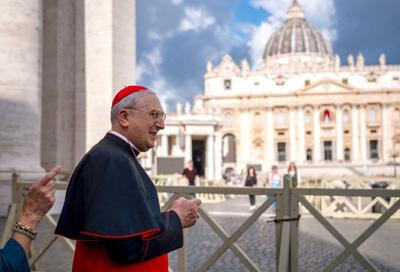ROME — The College of Cardinals gathered on Tuesday in the Vatican for the final meeting before the conclave to elect a new pope begins.
All cardinals in the Catholic Church are allowed to participate one last time in the so-called General Congregation of the College of Cardinals.
On Wednesday, the cardinals under the age of 80 — who are eligible to take part in the conclave — are due to enter the Sistine Chapel for the secret meeting to elect a new pope.
It is expected that 133 eligible cardinals from around the world will take part in the conclave.
The crowd in front of the Vatican gates was large on Tuesday, with all the cardinals having arrived in Rome.
For dozens of journalists, it was one of the last opportunities to ask the cardinals about their expectations. However, they appeared very reserved. Many did not walk to the Vatican despite the short distances but arrived by car. “A moment of peace!” one of the cardinals requested.
The election is being followed with great interest worldwide, even in countries without a large Catholic population. There are an estimated 1.4 billion Catholics worldwide.
Secret election
During the conclave, the cardinals are strictly isolated from the outside world in order to elect a successor to pope Francis, who passed away on Easter Monday at the age of 88.
They must hand in all smartphones and other electronic devices beforehand and spend the night in the Vatican guesthouse, Saint Martha’s House, and an older annex, where they are also not permitted any contact with the outside world. The cardinals will only be able to move around freely once a new pope has been elected.
Jammers are used to prevent any communication between the sealed-off area of the Vatican where the cardinals stay and the outside world. Anyone who needs access to the area, for example to provide for the cardinals or because of a medical emergency, must take an oath of secrecy.
A first vote is to be held on Wednesday afternoon, following a large Mass in St Peter’s Basilica in the morning. After that, two votes can be held each morning and two votes each afternoon.
A two-thirds majority is required for the election of a new pope. There is no time limit. In recent times however, conclaves have usually concluded after two or three days.
Shortly after the new pope is elected — indicated by white smoke billowing from the chimney on the Sistine Chapel — an official will pronounce the Latin phrase “habemus papam” (We have a pope) from the balcony of St Peter’s Basilica, with the name of the new pontiff.
The new pope then steps forward to appear before the public for the first time.
Francis’ successor
The competition to succeed Francis is open. Nonetheless, Vatican Secretary of State Cardinal Pietro Parolin, the Catholic Church’s current number two who will preside over the conclave, is considered a favourite.
In addition to Parolin, two other Italians are considered promising candidates: the archbishop of Bologna, Matteo Zuppi, and Patriarch of Jerusalem Pierbattista Pizzaballa. If one of them prevails, it would be the first time since 1978 that an Italian has held the office.
However, the list of possible new popes is growing longer by the day, currently including around two dozen names.







(0) comments
Welcome to the discussion.
Log In
Keep it Clean. Please avoid obscene, vulgar, lewd, racist or sexually-oriented language.
PLEASE TURN OFF YOUR CAPS LOCK.
Don't Threaten. Threats of harming another person will not be tolerated.
Be Truthful. Don't knowingly lie about anyone or anything.
Be Nice. No racism, sexism or any sort of -ism that is degrading to another person.
Be Proactive. Use the 'Report' link on each comment to let us know of abusive posts.
Share with Us. We'd love to hear eyewitness accounts, the history behind an article.